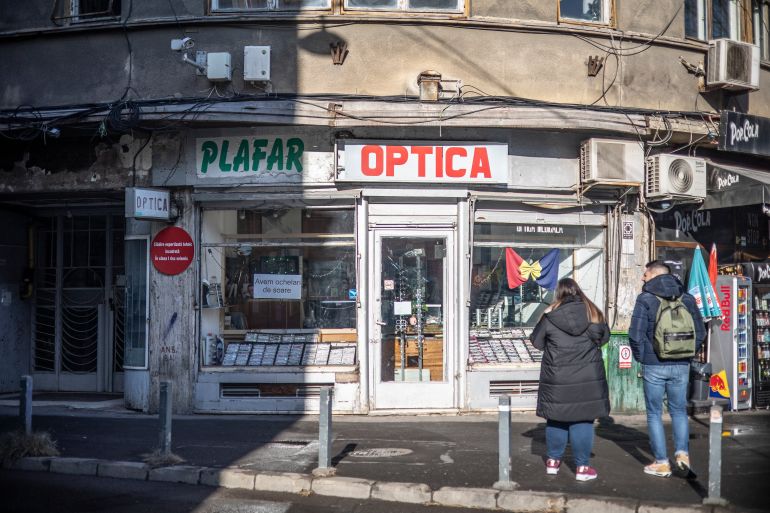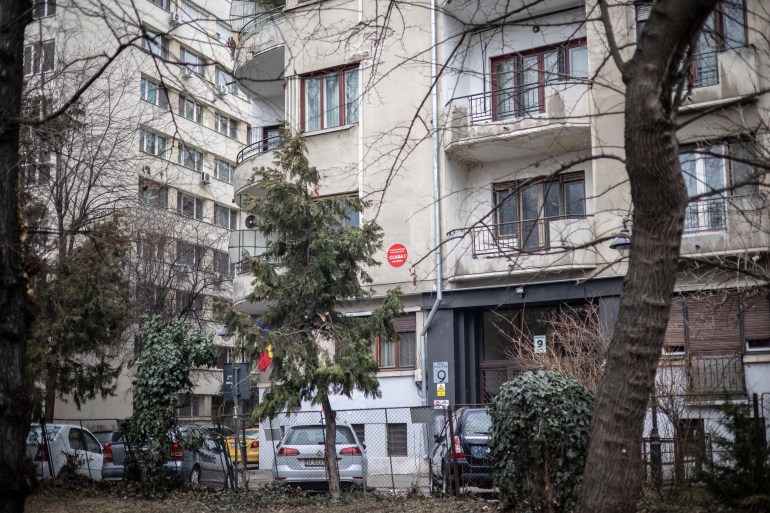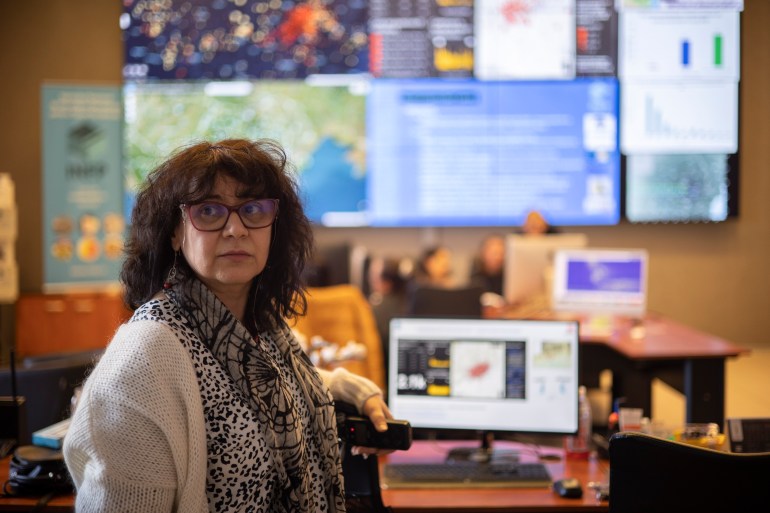Romania’s geeks are mapping earthquake risk in EU’s highest-risk capital
Since January, Romania has banned renting apartments in buildings at risk in an earthquake.

Bucharest, Romania – Under the catchy name “One Love Central Studio”, a renovated apartment with an open kitchen on Doamnei Street in Bucharest is advertised on the vacation rental website Booking.com for 53 euros ($57.30) per night in February.
“It is very well located,” mentioned a review on Google Maps. “The building is quite neglected,” posted another user. “Nice view,” the user added. “Old elevator,” a third one said.
Keep reading
list of 4 itemsIceland could send this Palestinian singer to Eurovision
Zelenskyy in Saudi Arabia to push for peace, POW deal with Russia
Why is Israel’s prime minister determined to attack Rafah?
However, the advertisement doesn’t specify this apartment is located in a building with a red dot, meaning it is classified as seismic risk class 1. On a scale of 1 to 4, one means a risk of collapse in a strong earthquake.
Romania has one of the highest earthquake hazards in Europe, alongside Turkey, Greece, Albania, and Italy. Bucharest is considered the European Union capital most at risk from earthquakes.
When the earth shakes, tremors evoke fears tied to the 1977 catastrophe that, according to the World Bank, claimed 1,578 lives in Romania and caused damages totalling approximately $2bn. March 4 will mark the 47th anniversary of the tragedy.
“Cutremur” (“earthquake” in Romanian) was the most searched word on Google in Romania in 2023 after the magnitude 7.8 earthquake in Turkey and Syria on February 6, and following the magnitude 5 earthquake in Gorj County, Romania, on February 14.
Those tragedies set alarm bells off in Romania, and new policies were proposed.
Last March, former Minister of Development Attila Cseke suggested a ban on renting apartments located in buildings with seismic risk level 1. The order was approved by the Parliament of Romania and took effect on January 1, 2024.
A quick search on rental websites shows that apartments in buildings with a red dot are still rented across Bucharest even though owners could face fines ranging from 5,000 lei ($1,088) and 10,000 lei ($2,175).
On the morning of February 27, two tourists were in front of the building with a seismic risk level 1 classification on Doamnei Street in Bucharest, with a suitcase and their smartphones in their hands. They confirmed they had just arrived and were waiting for their entry code. Against the wall, there was a row of boxes containing keys. They typed the code and entered.
Inside the building, in a lobby booth, the president of the community said that the apartments are not rented out, “only those booked through Booking,” she added, when this reporter mentioned having spoken with tourists who are staying there.
Questioned by Al Jazeera about whether they were aware that apartments in buildings vulnerable to earthquakes were still being advertised on their website, a spokesperson for Booking.com said via email: “We are aware of the new legislation and are considering how it applies to Booking.com.”
The company is “also highlighting that our accommodation partners should ensure that they are aware of their obligations and acting in accordance with all local laws”, the spokesperson for Booking.com added.
Using official data to map seismic risk
“I’m personally very content with this move of forbidding renting in red dots,” said Marina Batog, co-founder at engineering-focused NGO Make Better (MKBT).
“It is a first-ever step to halt speculation on seismic vulnerable buildings and mobilise private funds in seismic retrofitting,” she said, referring to a continuing trend of buying such apartments cheaply, often in cash, and renting them out at high rates after renovation.

The civic tech movement in Romania has used official data to map all the country’s buildings with a red dot.
As a joint project of Code for Romania and Make Better NGO, they created the website “acasainsiguranta.ro” (home safe), which provides resources to understand seismic risk and how to act, individually and collectively.
Aiming to “build technology to address societal issues”, Code for Romania emerged in late 2015, following the Colectiv nightclub fire in Bucharest, where 64 people died, explained its co-founder, Bogdan Ivanel.
After developing several tools during the COVID-19 pandemic and in the context of the war in Ukraine, they thought that “it made sense to work with what could be the next potential catastrophe in Romania — an earthquake,” Ivanel said.
They were inspired by “Codeando Mexico”, a civic innovation group that, after the 2017 Puebla earthquake, created a collaborative map of shelters, aid centres, and a survivor-volunteer database.
Batog said that they went door-to-door to red dot buildings and gathered data on their demography in 2016.
“We wanted to know who lives there,” she said. They found “a lot of vacant units”; units inhabited by old tenants who are reluctant to move out, and units rented by poorer groups, who “basically trade safety for price”, she added.
And a rising trend is that this kind of property is being acquired by affluent individuals paying in cash –“since red dot buildings are not bankable”, Batog said — who undertake renovations and rent them for offices or touristic apartments. “Hotels do need to pass inspections, Airbnbs don’t,” she added.
Bucharest’s countless vulnerable structures
Several laws have been passed in recent years to minimise the seismic risk in Romania, including one that came into effect in July 2022 to allow reinforcing buildings at seismic risk using state funds.

However, progress has been slow. Over the last 30 years, only 26 buildings in Romania have been renovated using public funds, with 19 of them located in Bucharest, according to the Ministry of Development, Public Works and Administration.
As part of Romania’s National Recovery and Resilience Plan, 220 million euros ($238m) will be invested in upgrading seismic resilience and energy efficiency for multi-family residences and public buildings in risk 1 and risk 2 categories, said a spokesperson of Romania’s Ministry of Development, Public Works and Administration via email.
“We have the vision, we have the money, we have the legislation, but we also need the involvement of all local authorities,” Adrian Veștea, the head of the ministry, posted on Facebook in October 2023.
A woman with shopping bags opened the door of a red-dot-marked building at Bucharest’s Victor Eftimiu alley one early February morning. Preferring anonymity, she said that the building will start renovation in August and the residents will relocate to government-provided apartments. “Rehabilitation may take a few years, and then we’ll return,” she said.
What if an earthquake happens before August? “Certainly, it’s a risk,” she conceded.
Building owners, including individuals and homeowner associations, along with property management entities, “are required to supervise the buildings that they own or manage and to technically expertise [them]”, said a ministry spokesperson.
Currently, 391 buildings in Bucharest are classified as risk 1 or at risk of collapse, but the figure could be much higher, as many buildings have not undergone technical expertise to assess their seismic vulnerability or they were evaluated back in the 90s, explained Teoalida, author of the interactive map: Harta Blocuri (“Bloc Map”).
Driven by his passion for communist architecture, in January 2018, Teoalida, who prefers to go by his nickname, started to create a comprehensive database for his hometown, Ploiesti, and later expanded it to include Bucharest and 10 of 40 counties across the country in 2023. He has dedicated about 2,000 hours voluntarily to the map.
“No one knows, not even authorities,” said Batog, when asked if the Romanian population is aware of all the edifices at risk.
The Bucharest City Committee for Emergency Situations in 2022 estimated that roughly 23,000 buildings in Bucharest could be “significantly damaged” in a strong earthquake, including dozens of schools, universities and hospitals.
A matter of seconds
The red lines move like sea waves on the huge screens in the National Research-Development Institute for Earth Physics of Romania (INCDFP) in Magurele, southwest of Bucharest.

“The ground is not static, it is always vibrating”, said Carmen Ortanza Cioflan, the INCDFP’s scientific director, pointing at a computer.
Someone monitors the graphs around the clock. At night, there are always two people.
Ortanza explained that when an earthquake strikes, the initial steps must be taken “in a matter of seconds”.
If the earthquake gets more than 4.5 on the Richter scale, in 25 seconds, “we are going to have public results from the earthquake early warning system (EEW),” she said.
The EEW is utilised to rapidly detect earthquakes, estimate real-time shaking hazards, and provide notifications before strong shaking occurs.
In Ortanza’s opinion, the EEW is “probably the biggest achievement so far” since the 1977 earthquake, as the response can either save lives or cause more damage.
Japan has had a widespread EEW system since 2007, and it’s now in use in several countries, including Mexico, Turkey, Romania, China, Italy and Taiwan.
“And we are making a lot of efforts in the educational level in mass media and also through dedicated projects,” Ortanza said.
Out of the more than 1,500 people who died in the 1977 earthquake, 480 individuals perished due to burns caused by gas fires, as gas was still being pumped after the earthquake.
Asked if this time Romania would be more prepared, Ortanza responded, “It depends.”
“We have to be prepared at a personal level, at the community level, at the institutional level, and throughout society,” she said. “Panic causes more victims than the earthquake or the building itself.”